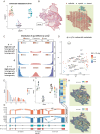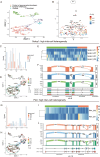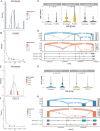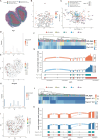Single cell and spatial alternative splicing analysis with Nanopore long read sequencing
- PMID: 40683866
- PMCID: PMC12276307
- DOI: 10.1038/s41467-025-60902-2
Single cell and spatial alternative splicing analysis with Nanopore long read sequencing
Abstract
Long-read sequencing boosts alternative splicing analysis but faces technical and computational barriers in single-cell and spatial settings. High Nanopore error rates compromise cell barcode and UMI recovery, while read truncation and misalignment undermine isoform quantification. Downstream, a statistical framework to assess splicing variation within and between cells or spatial spots is lacking. We introduce Longcell, a statistical and computational pipeline for isoform quantification from single-cell and spatially barcoded Nanopore long reads. Longcell efficiently recovers cell barcodes and UMIs, corrects sequencing errors, and models splicing diversity within and between cells or spots. Applied across multiple datasets, Longcell allows accurate identification of spatial isoform switching. Longcell also reveals widespread high intra-cell isoform heterogeneity for highly expressed genes. Finally, on a perturbation experiment for 9 splicing factors, Longcell identifies regulatory targets that are validated by targeted sequencing.
© 2025. The Author(s).
Conflict of interest statement
Competing interests: The authors declare no competing interests.
Figures







Update of
-
Single cell and spatial alternative splicing analysis with long read sequencing.Res Sq [Preprint]. 2023 Mar 21:rs.3.rs-2674892. doi: 10.21203/rs.3.rs-2674892/v1. Res Sq. 2023. Update in: Nat Commun. 2025 Jul 19;16(1):6654. doi: 10.1038/s41467-025-60902-2. PMID: 36993612 Free PMC article. Updated. Preprint.
References
MeSH terms
Substances
Grants and funding
LinkOut - more resources
Full Text Sources

